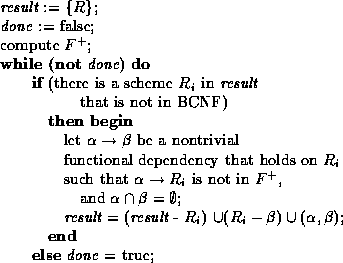 is in Boyce-Codd Normal Form (BCNF) with respect
to a set
is in Boyce-Codd Normal Form (BCNF) with respect
to a set  of functional dependencies if for all functional dependencies in
of functional dependencies if for all functional dependencies in  of the form
of the form
 , where
, where  and
and
 , at least one of the following holds:
, at least one of the following holds:
-
 is a trivial functional dependency
(i.e.
is a trivial functional dependency
(i.e.  ).
).
-
 is a superkey for scheme
is a superkey for scheme  .
.




Customer-scheme and Branch-scheme are in BCNF.
- We have the non-trivial functional dependency
loan#
 amount, and
amount, and
- loan# is not a superkey.
- Thus Borrow-scheme is not in BCNF.
- We also have the repetition of information problem.
- For each customer associated with a loan, we must repeat the branch name and amount of the loan.
- We can eliminate this redundancy by decomposing into schemes that are all in BCNF.

we have a lossless-join decomposition. (Remember why?)
To see whether these schemes are in BCNF, we need to know what functional dependencies apply to them.
- For Loan-info-scheme, we have
loan#
 amount bname applying.
amount bname applying.
- Only trivial functional dependencies apply to Cust-loan-scheme.
- Thus both schemes are in BCNF.
For the entire design to be in BCNF, we must also decompose Deposit-scheme into


- We replace a scheme
 with
with  and
and
 .
.
- The dependency
 holds on
holds on  .
.
-
 .
.
- So we have
 , and thus a
lossless join.
, and thus a
lossless join.

The set of functional dependencies we require to hold on this scheme are

A candidate key for this scheme is {loan#, cname}.
We will now proceed to decompose:
- The functional dependency

holds on Lending-scheme, but bname is not a superkey.
We replace Lending-scheme with

- Branch-scheme is now in BCNF.
- The functional dependency

holds on Borrow-scheme, but loan# is not a superkey.
We replace Borrow-scheme with

- These are both now in BCNF.
- We saw earlier that this decomposition is both lossless-join and dependency-preserving.
- Consider the relation scheme

- The set
 of functional dependencies is
of functional dependencies is

- The scheme is not in BCNF as banker is not a superkey.
- If we apply our algorithm, we may obtain the decomposition

- The decomposed schemes preserve only the first (and trivial) functional dependencies.
- The closure of this dependency does not include the second one.
- Thus a violation of cname bname
 banker cannot
be detected unless a join is computed.
banker cannot
be detected unless a join is computed.
- BCNF.
- Lossless join.
- Dependency preservation.

- There is sometimes more than one BCNF decomposition of a given scheme.
- The algorithm given produces only one of these possible decompositions.
- Some of the BCNF decompositions may also yield dependency preservation, while others may not.
- Changing the order in which the functional dependencies are considered
by the algorithm may change the decomposition.
- For example, try running the BCNF algorithm on

Then change the order of the last two functional dependencies and run the algorithm again. Check the two decompositions for dependency preservation.


